YAMAHA EX DELUXE 2021 Workshop Manual
Manufacturer: YAMAHA, Model Year: 2021, Model line: EX DELUXE, Model: YAMAHA EX DELUXE 2021Pages: 102, PDF Size: 4.72 MB
Page 51 of 102
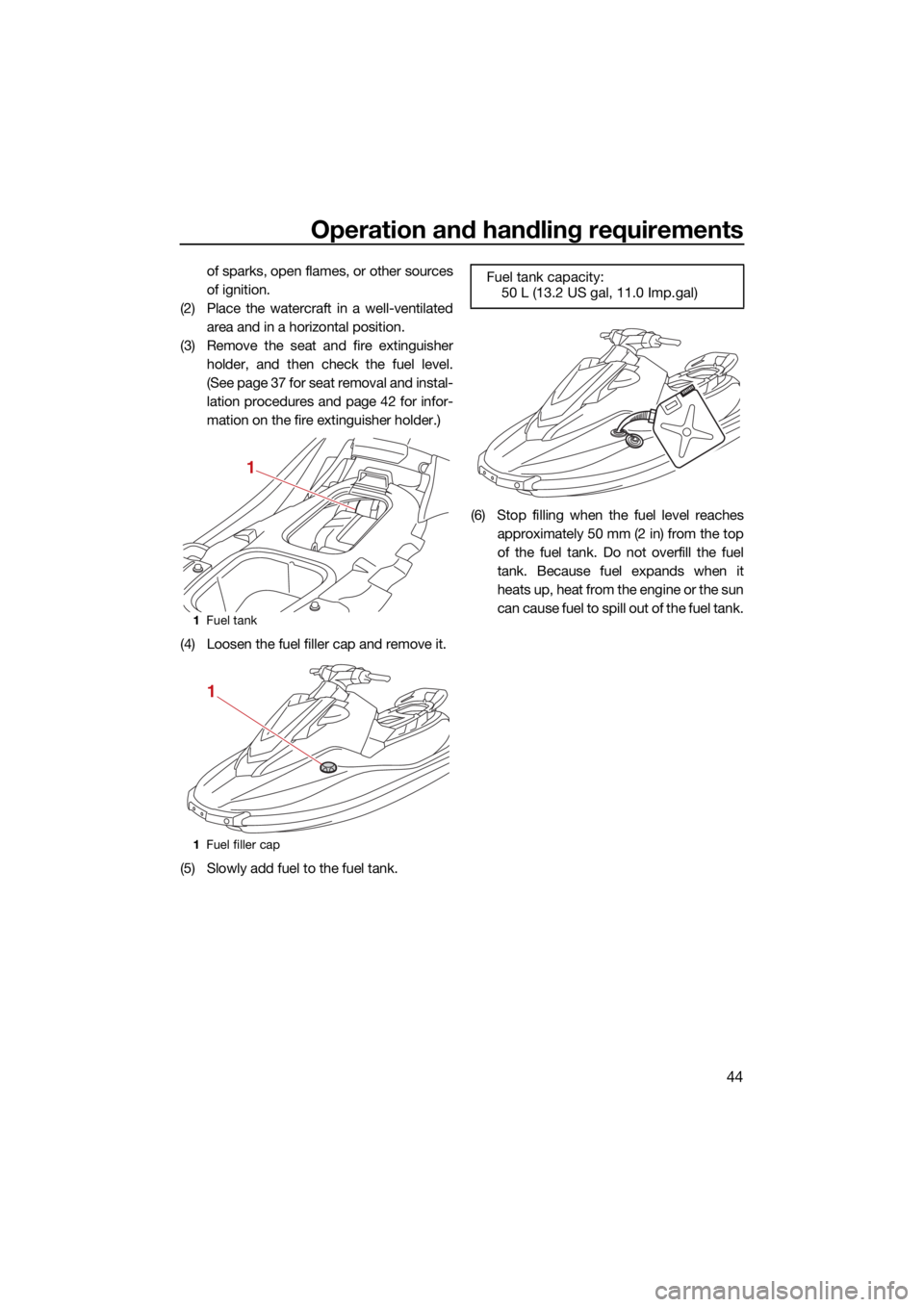
Operation and handling requirements
44
of sparks, open flames, or other sources
of ignition.
(2) Place the watercraft in a well-ventilated area and in a horizontal position.
(3) Remove the seat and fire extinguisher holder, and then check the fuel level.
(See page 37 for seat removal and instal-
lation procedures and page 42 for infor-
mation on the fire extinguisher holder.)
(4) Loosen the fuel filler cap and remove it.
(5) Slowly add fuel to the fuel tank. (6) Stop filling when the fuel level reaches
approximately 50 mm (2 in) from the top
of the fuel tank. Do not overfill the fuel
tank. Because fuel expands when it
heats up, heat from the engine or the sun
can cause fuel to spill out of the fuel tank.
1Fuel tank
1 Fuel filler cap
1
1
Fuel tank capacity:
50 L (13.2 US gal, 11.0 Imp.gal)
UF3Y74E0.book Page 44 Monday, June 22, 2020 5:11 PM
Page 52 of 102
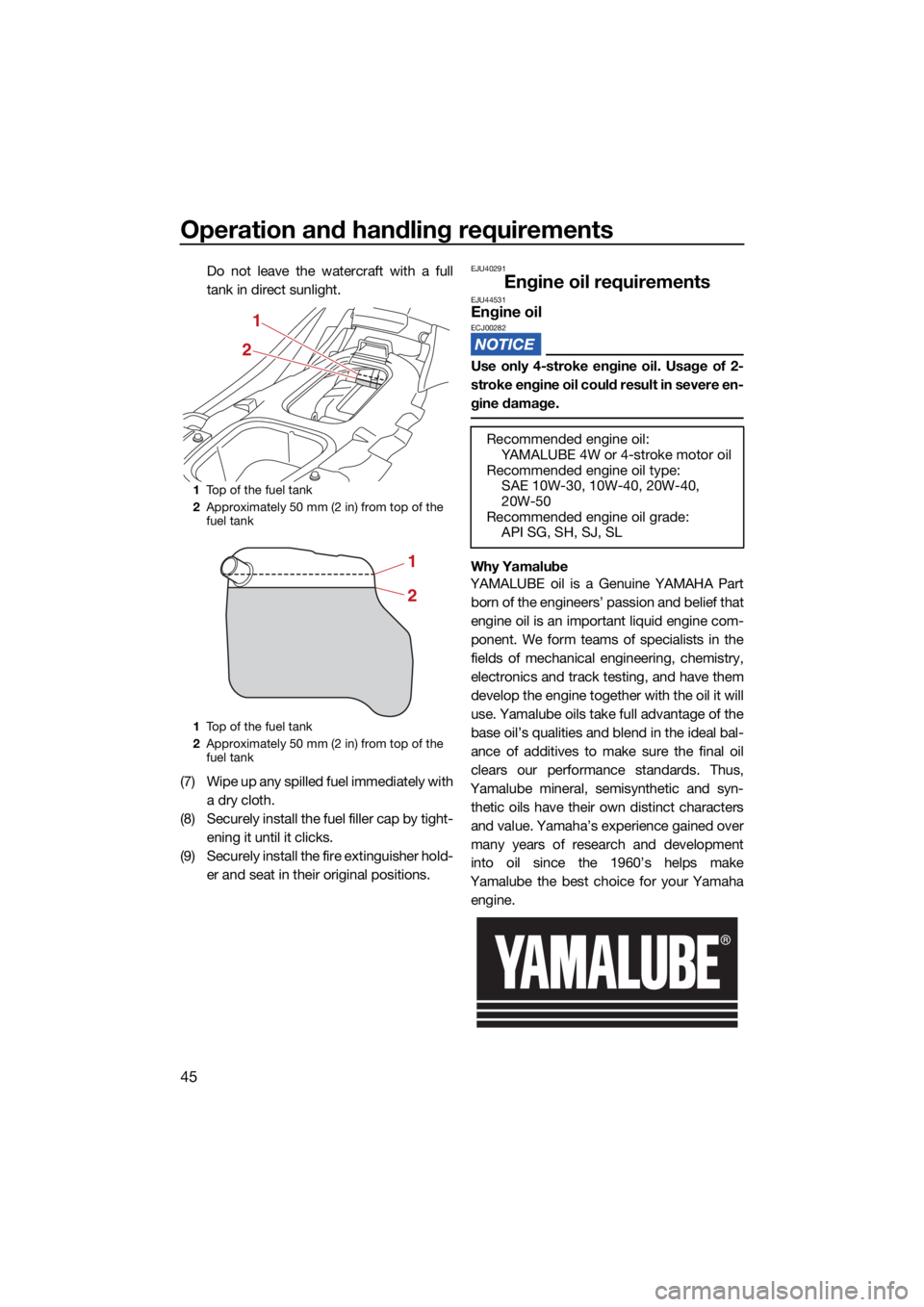
Operation and handling requirements
45
Do not leave the watercraft with a full
tank in direct sunlight.
(7) Wipe up any spilled fuel immediately with a dry cloth.
(8) Securely install the fuel filler cap by tight- ening it until it clicks.
(9) Securely install the fire extinguisher hold- er and seat in their original positions.EJU40291
Engine oil requirementsEJU44531Engine oilECJ00282
Use only 4-stroke engine oil. Usage of 2-
stroke engine oil could result in severe en-
gine damage.
Why Yamalube
YAMALUBE oil is a Genuine YAMAHA Part
born of the engineers’ passion and belief that
engine oil is an important liquid engine com-
ponent. We form teams of specialists in the
fields of mechanical engineering, chemistry,
electronics and track testing, and have them
develop the engine together with the oil it will
use. Yamalube oils take full advantage of the
base oil’s qualities and blend in the ideal bal-
ance of additives to make sure the final oil
clears our performance standards. Thus,
Yamalube mineral, semisynthetic and syn- thetic oils have their own distinct characters
and value. Yamaha’s experience gained over
many years of research and development
into oil since the 1960’s helps make
Yamalube the best choice for your Yamaha engine.
1 Top of the fuel tank
2 Approximately 50 mm (2 in) from top of the
fuel tank
1 Top of the fuel tank
2 Approximately 50 mm (2 in) from top of the
fuel tank
21
1
2
Recommended engine oil:
YAMALUBE 4W or 4-stroke motor oil
Recommended engine oil type: SAE 10W-30, 10W-40, 20W-40,
20W-50
Recommended engine oil grade: API SG, SH, SJ, SL
UF3Y74E0.book Page 45 Monday, June 22, 2020 5:11 PM
Page 53 of 102
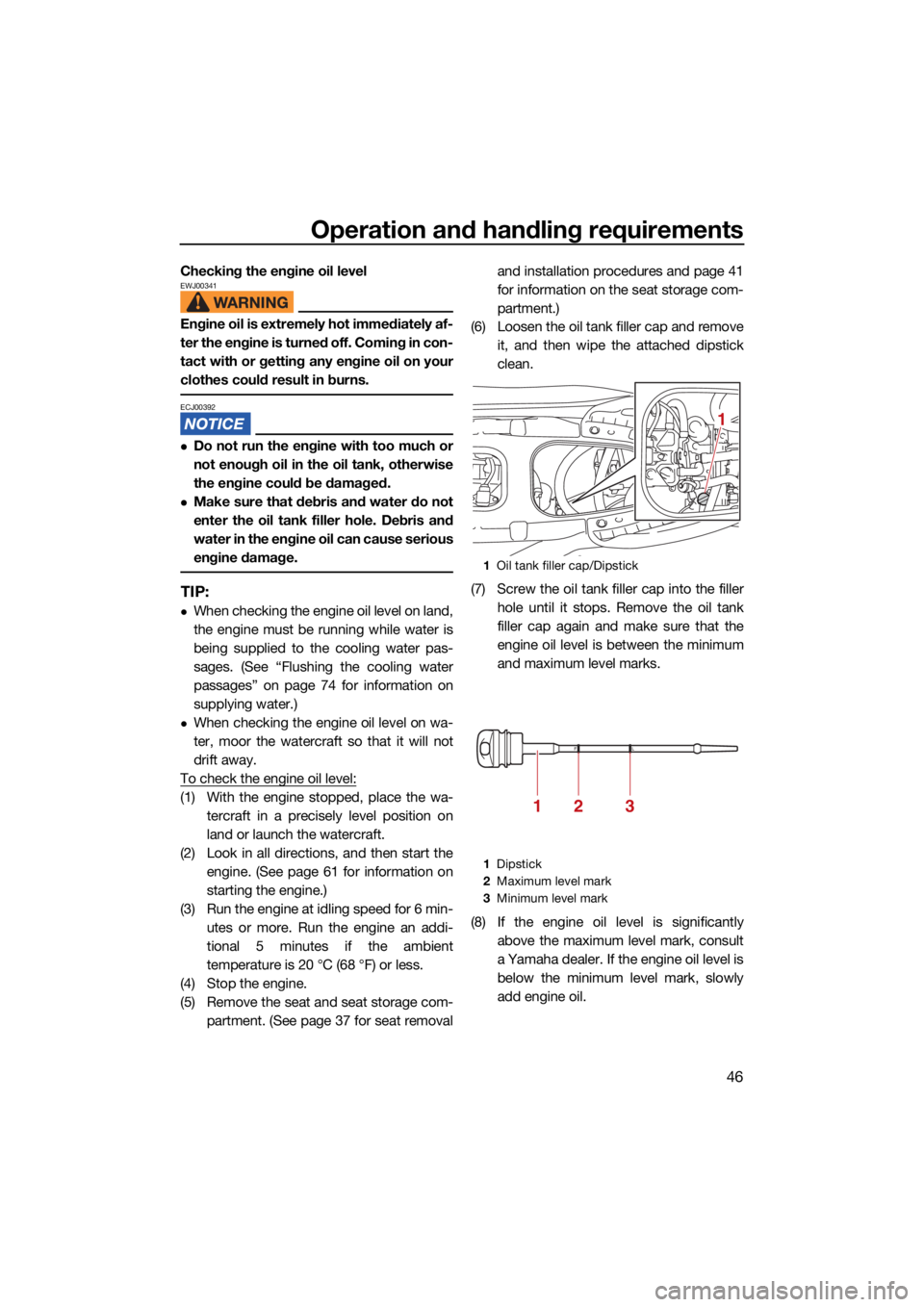
Operation and handling requirements
46
Checking the engine oil levelEWJ00341
Engine oil is extremely hot immediately af-
ter the engine is turned off. Coming in con-
tact with or getting any engine oil on your
clothes could result in burns.
ECJ00392
Do not run the engine with too much or
not enough oil in the oil tank, otherwise
the engine could be damaged.
Make sure that debris and water do not
enter the oil tank filler hole. Debris and
water in the engine oil can cause serious
engine damage.
TIP:
When checking the engine oil level on land,
the engine must be running while water is
being supplied to the cooling water pas-
sages. (See “Flushing the cooling water
passages” on page 74 for information on
supplying water.)
When checking the engine oil level on wa-
ter, moor the watercraft so that it will not
drift away.
To check the engine oil level:
(1) With the engine stopped, place the wa- tercraft in a precisely level position on
land or launch the watercraft.
(2) Look in all directions, and then start the engine. (See page 61 for information on
starting the engine.)
(3) Run the engine at idling speed for 6 min- utes or more. Run the engine an addi-
tional 5 minutes if the ambient
temperature is 20 °C (68 °F) or less.
(4) Stop the engine.
(5) Remove the seat and seat storage com- partment. (See page 37 for seat removal and installation procedures and page 41
for information on the seat storage com-
partment.)
(6) Loosen the oil tank filler cap and remove it, and then wipe the attached dipstick
clean.
(7) Screw the oil tank filler cap into the filler hole until it stops. Remove the oil tank
filler cap again and make sure that the
engine oil level is between the minimum
and maximum level marks.
(8) If the engine oil level is significantly above the maximum level mark, consult
a Yamaha dealer. If the engine oil level is
below the minimum level mark, slowly
add engine oil.
1Oil tank filler cap/Dipstick
1 Dipstick
2 Maximum level mark
3 Minimum level mark
1
213
UF3Y74E0.book Page 46 Monday, June 22, 2020 5:11 PM
Page 54 of 102
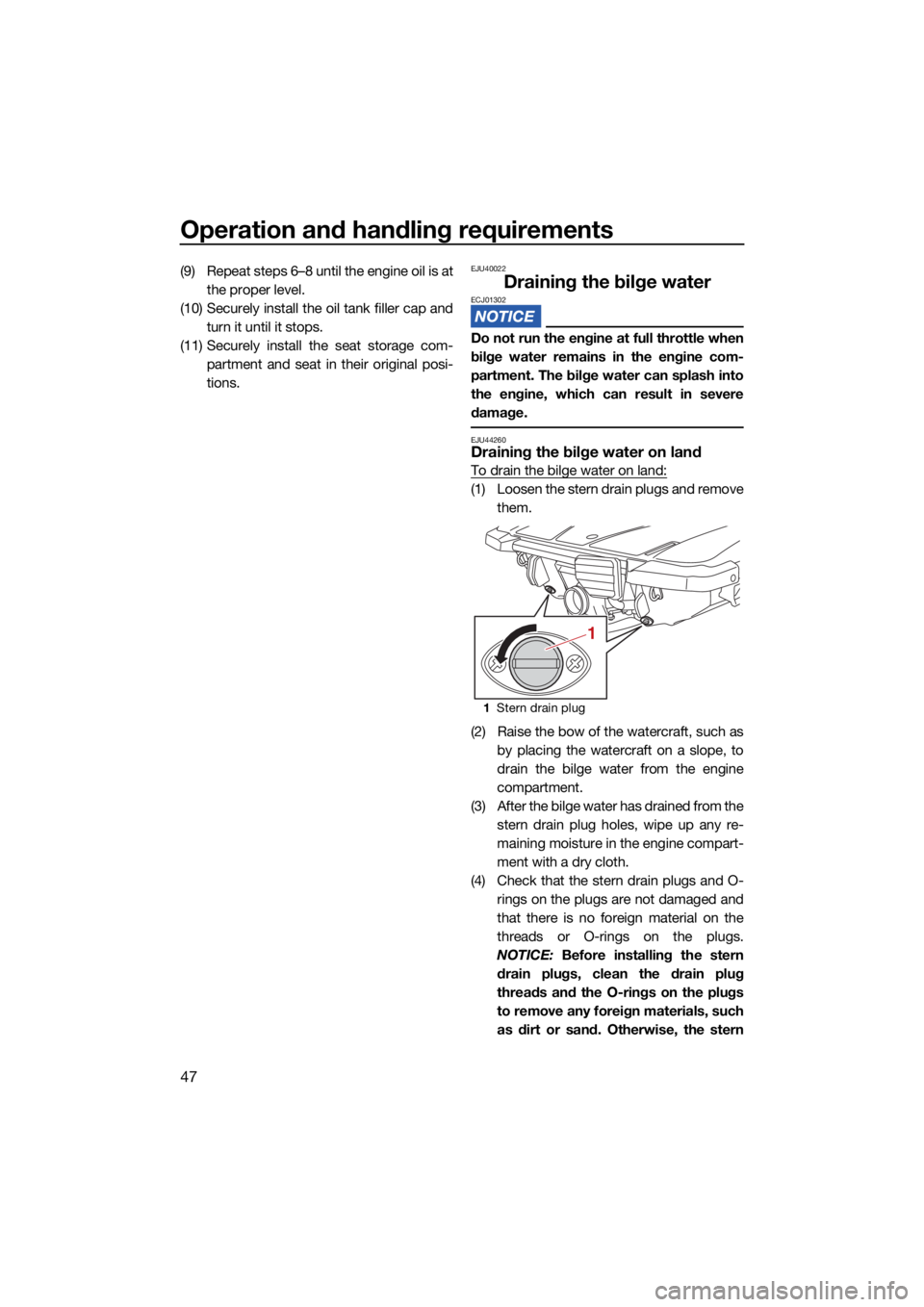
Operation and handling requirements
47
(9) Repeat steps 6–8 until the engine oil is atthe proper level.
(10) Securely install the oil tank filler cap and turn it until it stops.
(11) Securely install the seat storage com- partment and seat in their original posi-
tions.EJU40022
Draining the bilge waterECJ01302
Do not run the engine at full throttle when
bilge water remains in the engine com-
partment. The bilge water can splash into
the engine, which can result in severe
damage.
EJU44260Draining the bilge water on land
To drain the bilge water on land:
(1) Loosen the stern drain plugs and removethem.
(2) Raise the bow of the watercraft, such as by placing the watercraft on a slope, to
drain the bilge water from the engine
compartment.
(3) After the bilge water has drained from the stern drain plug holes, wipe up any re-
maining moisture in the engine compart-
ment with a dry cloth.
(4) Check that the stern drain plugs and O- rings on the plugs are not damaged and
that there is no foreign material on the
threads or O-rings on the plugs.
NOTICE: Before installing the stern
drain plugs, clean the drain plug
threads and the O-rings on the plugs
to remove any foreign materials, such
as dirt or sand. Otherwise, the stern
1 Stern drain plug
1
UF3Y74E0.book Page 47 Monday, June 22, 2020 5:11 PM
Page 55 of 102
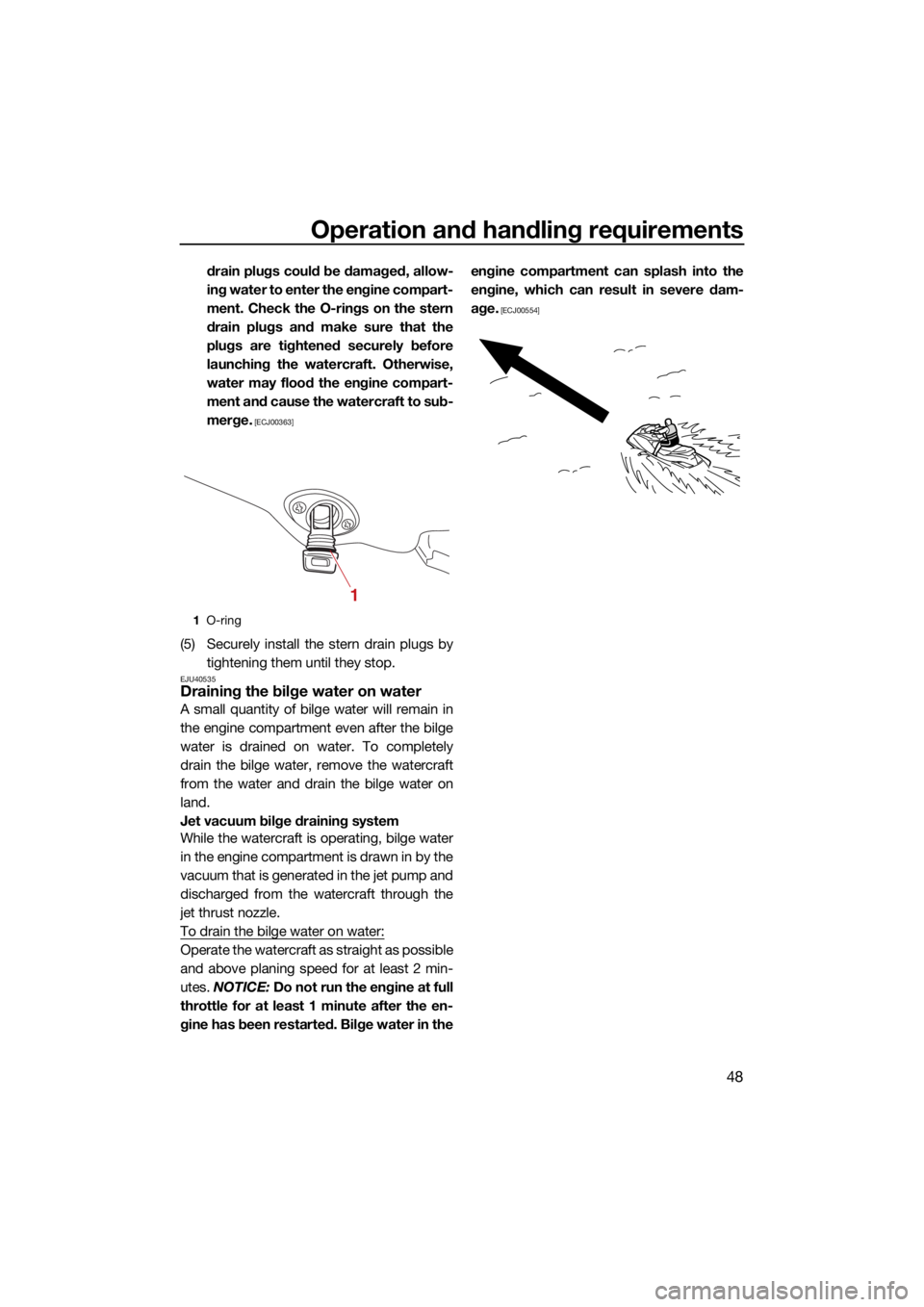
Operation and handling requirements
48
drain plugs could be damaged, allow-
ing water to enter the engine compart-
ment. Check the O-rings on the stern
drain plugs and make sure that the
plugs are tightened securely before
launching the watercraft. Otherwise,
water may flood the engine compart-
ment and cause the watercraft to sub-
merge.
[ECJ00363]
(5) Securely install the stern drain plugs bytightening them until they stop.
EJU40535Draining the bilge water on water
A small quantity of bilge water will remain in
the engine compartment even after the bilge
water is drained on water. To completely
drain the bilge water, remove the watercraft
from the water and drain the bilge water on
land.
Jet vacuum bilge draining system
While the watercraft is operating, bilge water
in the engine compartment is drawn in by the
vacuum that is generated in the jet pump and
discharged from the watercraft through the
jet thrust nozzle.
To drain the bilge water on water:
Operate the watercraft as straight as possible
and above planing speed for at least 2 min-
utes. NOTICE: Do not run the engine at full
throttle for at least 1 minute after the en-
gine has been restarted. Bilge water in the engine compartment can splash into the
engine, which can result in severe dam-
age.
[ECJ00554]
1
O-ring
1
UF3Y74E0.book Page 48 Monday, June 22, 2020 5:11 PM
Page 56 of 102
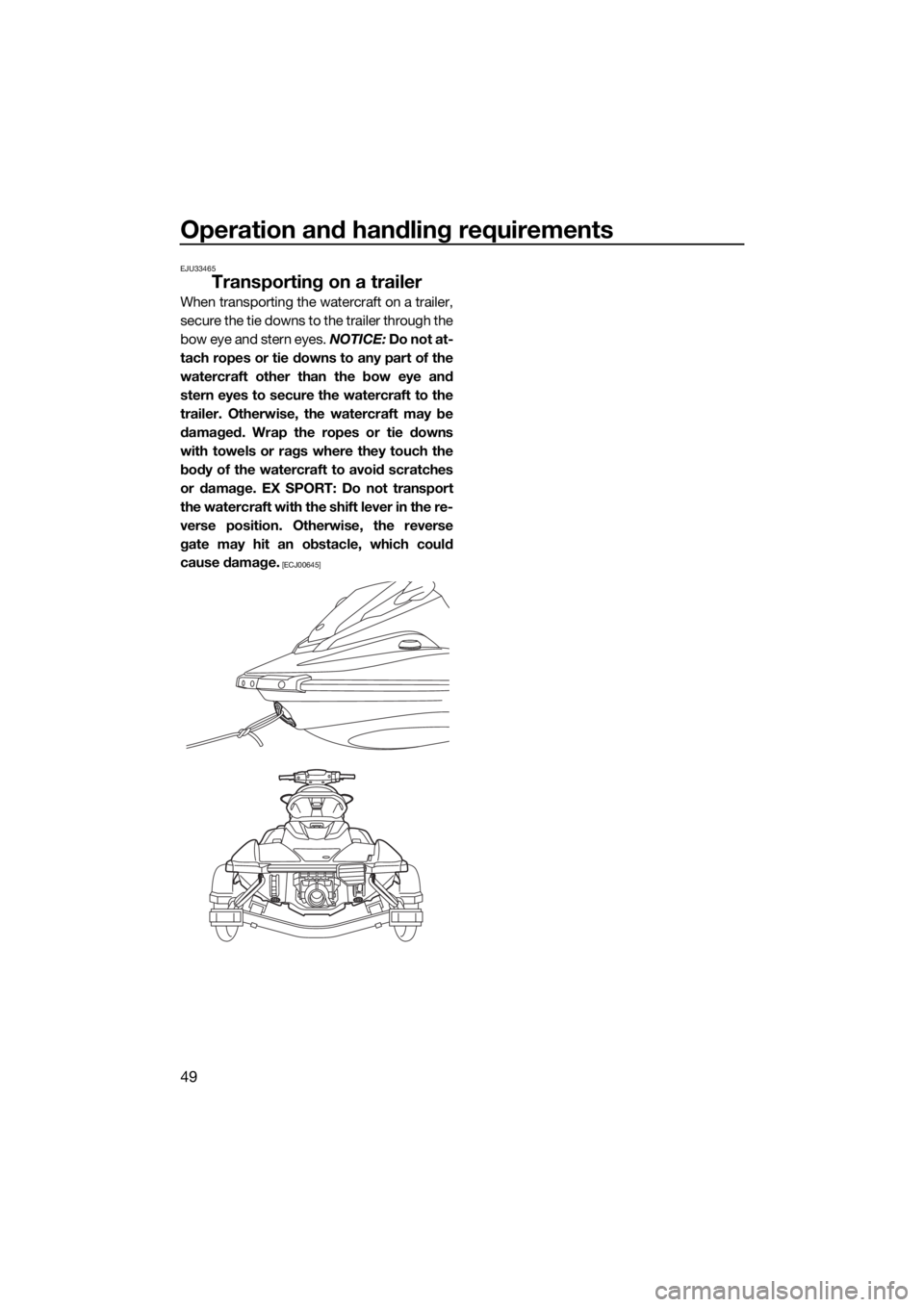
Operation and handling requirements
49
EJU33465
Transporting on a trailer
When transporting the watercraft on a trailer,
secure the tie downs to the trailer through the
bow eye and stern eyes. NOTICE: Do not at-
tach ropes or tie downs to any part of the
watercraft other than the bow eye and
stern eyes to secure the watercraft to the
trailer. Otherwise, the watercraft may be
damaged. Wrap the ropes or tie downs
with towels or rags where they touch the
body of the watercraft to avoid scratches
or damage. EX SPORT: Do not transport
the watercraft with the shift lever in the re-
verse position. Otherwise, the reverse
gate may hit an obstacle, which could
cause damage.
[ECJ00645]
UF3Y74E0.book Page 49 Monday, June 22, 2020 5:11 PM
Page 57 of 102

First-time operation
50
EJU32786
Engine break-inECJ00432
Failure to perform the engine break-in
could result in reduced engine life or even
severe engine damage.
The engine break-in is essential to allow the
various components of the engine to wear
and polish themselves to the correct operat-
ing clearances. This ensures proper perfor-
mance and promotes longer component life.
To perform the engine break-in:
(1) Check the engine oil level. (See page 45for information on checking the engine
oil level.)
(2) Launch the watercraft and start the en- gine. (See page 61 for information on
starting the engine.)
(3) For the first 5 minutes, operate with the engine at idling speed.
(4) For the next 30 minutes, operate with the engine speed below 5000 r/min.
(5) For the next 1 hour, operate with the en- gine speed below 6500 r/min.
After the engine break-in is complete, the wa-
tercraft can be operated normally.
UF3Y74E0.book Page 50 Monday, June 22, 2020 5:11 PM
Page 58 of 102

Pre-operation checks
51
EJU31982
EWJ00412
Failure to inspect or maintain the watercraft properly increases the possibility of an ac-
cident or damage to the watercraft. Do not operate the watercraft if you find any prob-
lem. If a problem cannot be corrected by the procedures provided in this manual, have
the watercraft inspected by a Yamaha dealer.
EJU41235Pre-operation checklist
Before using this watercraft, be sure to perform the checks in the following checklist.
ITEMROUTINEPAGE
PRE-LAUNCH CHECKS
Engine compartment Ventilate the engine compartment.
Check inside the engine compartment for damage.
53
Fuel system Check the fuel system for leakage.
Check the fuel level in the fuel tank.
53
Water separator Check the water separator for water. 54
Engine unit Check the exterior of the engine unit for damage. 54
Engine oil level Check the engine oil level. 54
Bilge water Check the engine compartment for bilge water. 54
Battery Check the battery connections. 54
Steering system Check the steering system for proper operation. 55
Reverse system (EX
SPORT) Check the reverse system for proper operation.
55
RiDE lever (EX DELUXE /
EX LIMITED) Check the RiDE lever for proper operation.
56
Throttle lever Check the throttle lever for proper operation. 56
Engine shut-off cord (lan-
yard) Check the engine shut-off cord (lanyard) for dam-
age.
56
Switches Check the start switch, engine stop switch, and en-
gine shut-off switch for proper operation.
57
Storage compartments Check the storage compartments for damage and
water.
57
Fire extinguisher holder Check the fire extinguisher holder for damage. 57
Fire extinguisher Check the condition of the fire extinguisher. 57
Safety equipment Check that safety equipment meeting the applica-
ble regulations is on board.
58
Hull and deck Check the hull and deck for damage. 58
Jet intake Check the jet intake for damage and clogging. 58
Jet thrust nozzle and re-
verse gate (EX SPORT / EX
DELUXE / EX LIMITED) Check the jet thrust nozzle and reverse gate for
damage.
58
UF3Y74E0.book Page 51 Monday, June 22, 2020 5:11 PM
Page 59 of 102

Pre-operation checks
52
TIP:
To ensure safety and reliability, pre-operation checks should be made each time the water-
craft is used.
Stern drain plugs Check the stern drain plugs for damage and foreign
material and check that they are securely installed.
58
Hood Check that the hood is securely closed. 58
Seat Check that the seat is securely installed. 37
POST-LAUNCH CHECKS
Cooling water pilot outlet Check that water is discharged from the cooling
water pilot outlet while the engine is running.
59
Multifunction information
center Check the multifunction information center for prop-
er operation.
59
Shift system (EX DELUXE /
EX LIMITED) Check the shift system for proper operation. 59
Engine idling speed Check the engine idling speed. 59
ITEM ROUTINE PAGE
UF3Y74E0.book Page 52 Monday, June 22, 2020 5:11 PM
Page 60 of 102
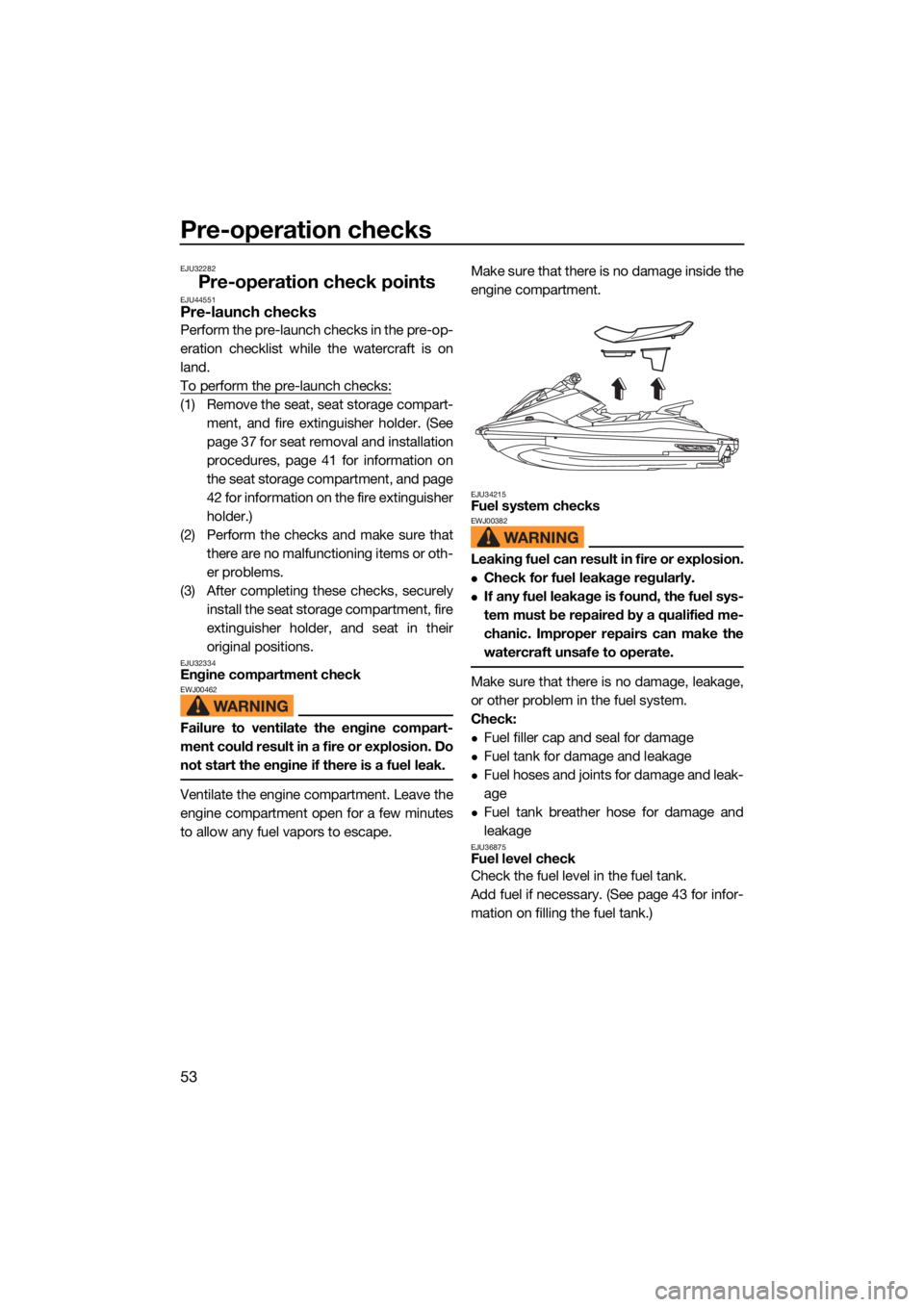
Pre-operation checks
53
EJU32282
Pre-operation check pointsEJU44551Pre-launch checks
Perform the pre-launch checks in the pre-op-
eration checklist while the watercraft is on
land.
To perform the pre-launch checks:
(1) Remove the seat, seat storage compart-ment, and fire extinguisher holder. (See
page 37 for seat removal and installation
procedures, page 41 for information on
the seat storage compartment, and page
42 for information on the fire extinguisher
holder.)
(2) Perform the checks and make sure that there are no malfunctioning items or oth-
er problems.
(3) After completing these checks, securely install the seat storage compartment, fire
extinguisher holder, and seat in their
original positions.
EJU32334Engine compartment checkEWJ00462
Failure to ventilate the engine compart-
ment could result in a fire or explosion. Do
not start the engine if there is a fuel leak.
Ventilate the engine compartment. Leave the
engine compartment open for a few minutes
to allow any fuel vapors to escape. Make sure that there is no damage inside the
engine compartment.
EJU34215Fuel system checksEWJ00382
Leaking fuel can result in fire or explosion.
Check for fuel leakage regularly.
If any fuel leakage is found, the fuel sys-
tem must be repaired by a qualified me-
chanic. Improper repairs can make the
watercraft unsafe to operate.
Make sure that there is no damage, leakage,
or other problem in the fuel system.
Check:
Fuel filler cap and seal for damage
Fuel tank for damage and leakage
Fuel hoses and joints for damage and leak-
age
Fuel tank breather hose for damage and
leakage
EJU36875Fuel level check
Check the fuel level in the fuel tank.
Add fuel if necessary. (See page 43 for infor-
mation on filling the fuel tank.)
UF3Y74E0.book Page 53 Monday, June 22, 2020 5:11 PM